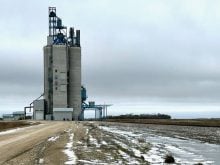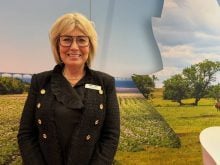A survey of bats in southern Alberta along the Milk River watershed is pushing out one more drive for participants to join a bat count as white-nose syndrome spreads across the continent.
Alberta has had no reported cases of white-nose syndrome, which is caused by a fungal infection, but researcher Allison Choquette, wildlife technician at the Milk River Watershed Council Canada (MRWCC), said that’s likely to change.
Part of the reason for the survey is to be able to measure impacts if or when the infection spreads to Alberta.
Read Also

Farmland ownership fires up Saskatchewan politicians
Saskatchewan politicians debate the enforcement of farmland ownership laws in the province.
Millions of bats across Canada and the United States have died of the infection, which has spread westward since first being detected in New York state in 2006.
Choquette said 28 private landowners along the watershed have taken part in the survey but she hopes more will join before the research project wraps up at the end of summer.
“I’m trying to hit everywhere and get a good dispersion of landowners, so we have data across the watershed,” she said, adding that the survey has run between Whiskey Gap to Aden.
Little brown bats are the primary focus of the survey because they are the most susceptible to white-nose syndrome and are the most endangered of the several species found in Alberta.
The survey uses a sonic listening device to pick up bat calls inaudible to humans. In return, participating landowners receive a bat house to help bolster the insect-eating mammal’s habitat.
“Bats are pretty elusive within Alberta. There is not a lot of research done,” she said. “Bats are so beneficial both environmentally and economically. They eat a ton of insects, so they help reduce pests and the burden on farmers and reduce pesticide use.”
While Alberta has done little research on bat populations, Milk River specifically has next to none, especially on private property, said Choquette, something she hopes to change.
The audio recordings of bats will be submitted to the continent-wide North American Bat Monitoring Program through the province’s Alberta eBat program.
Choquette said when it comes to data from the Milk River watershed currently recorded in either database, “there was nothing there. There were barely any recordings and submissions.”
The digital records can be analyzed to tell the differences in bat species and various activities they’re undertaking, such as feeding.
“So far, we’ve given out 45 bat houses to these participating landowners as a thank you for allowing to access their land and put out this recorder,” said Choquette.
While bat houses typically take some time to attract residents, Choquette said two have become occupied already, which replaced older and misplaced houses.
“That just goes to show that placement and design of the bat house does play a big role in the bat’s choice of habitat.”
Some knowledge of where bat populations might be on a given property does help but Choquette said getting assistance to set up the equipment is the most important help the research can receive.
“Just reaching out to me and allowing me to come by on to the property and agreeing to be good stewards for the bats is really all we need,” she said.
She is particularly looking for landowners in riparian areas or places with large trees, old barns or hoodoos.
Those wishing to take part in the survey can contact Allison Choquette via email at allison@mrwcc.ca.
Photos and videos of the work can be found on the Milk River Watershed Council Canada Facebook page.
















